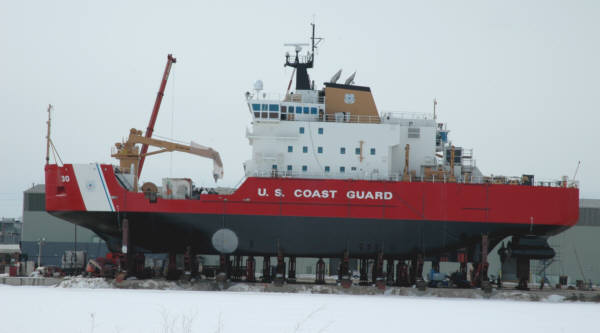
Ice-breakers like this might not be needed if global warming continues. Global Warming Causing Lack of Ice?
|
||||||||||
| Printer Friendly Story View |
(EDITOR'S NOTE: Current warm winter is perplexing weather experts and frustrating sports enthusiasts in Michigan accustomed to ice fishing, skiing and outdoor sports made possible by snow and ice cover. The following reports raise issues of great concern but the longterm effect of global warming on Michigan remains uncertain.)
The global average temperature for December was the ninth warmest on record.
Even though December 2005 started with unusually cold conditions across much of the nation, including the Midwest and Michigan, it ended with an unusual warming trend that dissipated much of the ice mass on streams, rivers and lakes in this region.
The nationally averaged temperature for December was near the long-term average but 2005 still was the 13th warmest year since national records began in 1895, according to NOAA’s National Climate Data Center (NCDC) in Asheville, N.C.


NCDC scientists said the average temperature for the contiguous United States for December was 33.5 F (0.8°C), identical to the 1895-2004 mean.
Colder-than-average conditions covered much of the nation during the first half of the month, as upper-level winds steered Arctic air into the southern U.S. A strong snowstorm moved across the Midwest and Northeast Dec. 8 and 9, and a damaging ice storm struck parts of the Southeast mid-month.
Atmospheric circulation changes during the last two weeks of the month brought a retreat of the Arctic air mass and put the country under the influence of warmer air from the Pacific. Temperatures for the last week of December were more than 15 F above average in areas of the northern Plains and West, which had experienced extremely cold conditions in early December. For the year as a whole, the contiguous U.S. was 1.2° F (0.7°C) warmer than average, said NCDC.
In a related report, global warming maydecimate the top 10 feet (3 meters) or more of perennially frozen soil across the Northern Hemisphere, altering ecosystems as well as damaging buildings and roads across Canada, Alaska, and Russia.
New simulations from the National Center forAtmospheric Research (NCAR) show that over half of the area covered by this topmost layer of permafrost could thaw by 2050 and as much as 90 percent by 2100. Scientists expect the thawing to increase runoff to the Arctic Ocean and release vast amounts ofcarbon into the atmosphere.


The study, using the NCAR-based Community Climate System Model (CCSM), is the first to examine the state of permafrost in a global model that includes interactions among the atmosphere, ocean, land, and sea ice as well as a soil model that depicts freezing and thawing. Results appear online in the December 17 issue of Geophysical Research Letters. (http://www.agu.org/journals/gl/)
"People have used models to study permafrost before, but not within a fully interactive climate system model," says NCAR's David Lawrence, the lead author. The coauthor is Andrew Slater of the University of Colorado's National Snow and Ice Data Center.
About a quarter of the Northern Hemisphere's land contains permafrost, defined as soil that remains below 32 degrees F (0 degrees C) for at least two years. Permafrost is typically characterized by an active surface layer, extending anywhere from a few centimeters to several meters deep, which thaws during the summer and refreezes during the winter. The deeper permafrost layer remains frozen. The active layer responds to changes in climate, expanding downward as surface air temperatures rise. Deeper permafrost has not thawed since the last ice age, over 10,000 years ago, and will be largely unaffected by global warming in the coming century, says Lawrence.
Recent warming has degraded large sections of permafrost across central Alaska, with pockets of soil collapsing as the ice within it melts. The results include buckled highways, destabilized houses, and "drunken forests"--trees that lean at wild angles. In Siberia, some industrial facilities have reported significant damage. Further loss of permafrost could threaten migration patterns of animals such as reindeer and caribou.
The CCSM simulations are based on high and low projections of greenhouse-gas emissions for the 21st century, as constructed by the Intergovernmental Panel on Climate Change. In both cases, the CCSM determined which land areas would retain permafrost at each of 10 soil depths extending down to 11.2 feet (3.43 meters).
For the high-emission scenario,the area with permafrost in any of these layers shrinks from 4 million to just over 1 million square miles by the year 2050 and decreases further to about 400,000 square miles (1 million square kilometers) by 2100. In the low-emission scenario, which assumes major advances in conservation and alternative energy, the permafrost area shrinks to about 1.5 million square miles by 2100.
"Thawing permafrost could send considerable amounts of water to the oceans," says Slater, who notes that runoff to the Arctic has increased about 7 percent since the 1930s. In the high-emission simulation, runoff grows by another 28 percent by the year 2100. That increase includes contributions from enhanced rainfall and snowfall as well as the water from ice melting within soil.
The new study highlights concern about emissions of greenhouse gases from thawing soils. Permafrost may hold 30 percent or more of all the carbon stored in soils worldwide. As the permafrost thaws, it could lead to large-scale emissions of methane or carbon dioxide beyond those produced by fossil fuels.###
| Printer Friendly Story View |
|
|

Dave Rogers |
|
|
|
Printer-Friendly Story View
0200 Nd: 04-21-2024 d 4 cpr 0
12/31/2020 P3v3-0200-Ad.cfm
SPONSORED LINKS
12/31/2020 drop ads P3v3-0200-Ad.cfm


